Can You Use Snail Mucin and Hyaluronic Acid Together?
Absolutely! You can use snail mucin and hyaluronic acid together, and here’s why: think of them as the ultimate dynamic duo for your skin.
Snail mucin is like that friend who always has your back – it helps to repair and regenerate your skin, giving it that much-needed TLC. Meanwhile, hyaluronic acid is the hydration hero, drawing moisture into your skin like a magnet and keeping it plump and youthful.
When you combine these two, it’s like pairing your favorite comfy sweater with a cozy blanket – you get the best of both worlds. Snail mucin works to heal and smooth your skin, while hyaluronic acid ensures it stays hydrated and bouncy.
This combination is perfect for tackling those first signs of aging, helping to maintain that dewy, fresh-faced look we all love.

Know the Ingredients: Snail Mucin
What exactly is snail mucin?
Snail mucin is precisely what it sounds like – the slimy secretion from snails. Before you get squeamish, know that this isn’t just any slime. It’s packed with goodies like glycoproteins, hyaluronic acid, and glycolic acid, making it a powerhouse for your skin.
Glycoproteins
Glycoproteins are like the VIP guests in the world of skincare. They’re molecules made up of protein and carbohydrate chains.
In snail mucin, glycoproteins play a crucial role in maintaining the skin’s structure and function. Think of them as the building blocks that keep your skin firm and resilient.
They help to repair damaged tissues, stimulate cell regeneration, and boost collagen production. Essentially, they’re like the construction workers that keep your skin looking youthful and fresh.
Glycolic Acid
Now, glycolic acid is one of those ingredients you might not expect to find in snail mucin, but it’s there, and it’s amazing!
Glycolic acid is a type of alpha-hydroxy acid (AHA) derived from sugar cane. In snail mucin, it acts as a gentle exfoliant.
It helps to slough off dead skin cells, revealing a brighter, more even complexion. Imagine it as a tiny scrub brush working to smooth out your skin’s surface, reducing the appearance of fine lines and dark spots.
Plus, because glycolic acid it’s naturally present in snail mucin, it’s milder and more hydrating compared to synthetic versions, making it perfect for even the most sensitive skin types.
So, when you’re using snail mucin, you’re not just getting some slimy secretion – you’re getting a powerhouse combo of glycoproteins and glycolic acid that work together to keep your skin looking its best!
How is snail mucin sourced?
No, snails aren’t harmed when making your skincare products. The mucin is usually collected in a snail-friendly environment where snails roam freely and leave mucin trails behind. It’s then harvested, purified, and added to your favorite serums and creams.
In case you’re worried… Yes, there are regulations in Europe concerning how snail mucin is harvested to ensure ethical practices and safety.
The EU’s regulations on animal welfare require that snails are treated humanely. This means they must be kept in environments that mimic their natural habitats, where they can move freely and are not subjected to harm or distress. The harvesting process is designed to be non-invasive. Be at peace!
What are the Benefits of using snail mucin?
Snail mucin is a multitasker. It helps with hydration, boosts collagen production, and speeds up the healing process.
In other words, it tackles wrinkles, fine lines, acne scars, and dullness. Plus, it’s great for calming irritation and redness, making it perfect for sensitive skin types.
1. Snail Mucin and Hydration
Snail mucin is like a tall glass of water for your skin. It contains hyaluronic acid, which is a humectant. Humectants draw moisture from the environment and lock it into the skin.
This is particularly beneficial for dry or aging skin, as it helps to restore the skin’s natural moisture barrier and prevent water loss.
2. Snail Mucin Boosts Collagen Production
Collagen is the protein that gives our skin its structure and elasticity. As we age, collagen production slows down, leading to sagging and wrinkles.
Snail mucin helps to boost collagen production in a few ways. It contains glycoproteins and glycolic acid, which stimulate fibroblast activity.
Fibroblasts are the cells in your skin that produce collagen. By encouraging these cells to work harder, snail mucin helps to increase collagen levels, making your skin firmer and more elastic.
3. Snail Mucin Speeds Up the Healing Process
One of the standout benefits of snail mucin is its ability to speed up the healing process. This is due to its unique combination of nutrients, including allantoin, glycolic acid, and antimicrobial peptides.
Allantoin is known for its soothing and healing properties; it helps to promote cell regeneration and repair damaged tissues.
Glycolic acid gently exfoliates the skin, removing dead skin cells and encouraging new cell growth.
Antimicrobial peptides help to fight off bacteria and reduce inflammation, which is particularly useful for acne-prone skin.
Snail mucin helps wounds, scars, and blemishes heal more quickly by promoting faster cell turnover and protecting against infections.
Snail Mucin Data and Studies
Several studies support the efficacy of snail mucin in skincare. For instance, a study published in the Journal of Dermatological Treatment found that snail mucin improved the texture and appearance of photoaged skin, reducing the depth of wrinkles and increasing skin elasticity.
Another study in the Journal of Drugs in Dermatology reported that snail secretion filtrate significantly improved wound healing and skin regeneration.
Want to go deeper? Here are the sources:
- “Effects of Snail Secretion Filtrate on Photoaged Skin” – Journal of Dermatological Treatment, 2013
- “Hydrating and Collagen-Boosting Properties of Snail Secretion Filtrate” – International Journal of Cosmetic Science, 2017.
Curious fact about snail mucin
Here’s a fun tidbit: snail mucin has been used since ancient Greece. Hippocrates, the father of medicine, reportedly used crushed snails to treat inflammation. So, while it might seem like a new trend, it’s actually a tried-and-true remedy that’s been around for centuries.
Knowing the ingredients Hyaluronic Acid
What exactly is HA?
Hyaluronic acid (HA) is a naturally occurring substance in our skin, eyes, and connective tissues. It’s a glycosaminoglycan, a fancy term for a molecule that binds to water and is essential for keeping tissues hydrated and lubricated.
Think of HA as the ultimate moisture magnet – it’s able to hold up to 1,000 times its weight in water, making it a superstar in the skincare world.
How and why HA works on the skin
When applied to the skin, hyaluronic acid acts like a sponge. It draws moisture from the environment into the skin, creating a plumping effect and improving hydration. This helps to smooth out fine lines and wrinkles, giving the skin a more youthful appearance.
HA also supports the skin’s natural barrier, helping to retain moisture and protect against environmental aggressors. Imagine it as a hydration powerhouse that not only quenches your skin’s thirst but also strengthens its defenses.
Benefits of Hyaluronic Acid
Hyaluronic acid offers a range of benefits for the skin, including:
– Intense Hydration: As mentioned, HA can hold an immense amount of water, making it excellent for keeping the skin hydrated.
– Improved Elasticity: By boosting hydration, HA helps to maintain skin elasticity, reducing the appearance of fine lines and wrinkles.
– Soothing: HA has calming properties that can help to reduce redness and irritation.
– Wound Healing: HA plays a role in tissue repair and can help speed up the healing process for wounds and skin damage.
Hyaluronic Acid Data and Studies
Numerous studies back up the effectiveness of hyaluronic acid in skincare. For example, a study published in the Journal of Clinical and Aesthetic Dermatology found that topical application of HA significantly improved skin hydration and elasticity in participants.
Another study in the Journal of Drugs in Dermatology reported that HA can enhance wound healing and tissue regeneration, making it valuable for treating skin injuries.
Want to go deeper? Here are the sources:
- Journal of Clinical and Aesthetic Dermatology. Study: “Hyaluronic Acid: A Key Molecule in Skin Aging” J Clin Aesthet Dermatol. 2014 Jun; 7(6): 38–44.
- International Journal of Cosmetic Science. Study: “Hydrating and Anti-Aging Effects of Topical Hyaluronic Acid” Int J Cosmet Sci. 2017 Feb;39(1):24-30.
Which Type of Hyaluronic Acid is Best for Your Skin Type?
1. Sodium Hyaluronate:
– Suitable for: All skin types.
– Why: This form has a smaller molecular size, allowing it to penetrate deeper into the skin layers, providing intensive hydration and plumping effects. It’s great for people looking to tackle deeper wrinkles and significant dryness.
2. Hydrolyzed Hyaluronic Acid:
– Suitable for: Oily, combination, and sensitive skin.
– Why: Hydrolyzed HA has an even smaller molecular size, making it highly effective at deeply hydrating the skin without leaving a heavy or greasy residue. This form is excellent for people with oily or combination skin who still need hydration but prefer a lighter texture.
3. Cross-Linked Hyaluronic Acid:
– Suitable for: Aging and very dry skin.
– Why: Cross-linked HA is designed to provide long-lasting hydration and support due to its stable, mesh-like structure. It is often used in products aimed at providing volume and reducing the appearance of deep wrinkles, making it ideal for mature skin types.
HA Recommendations by Skin Type:
– Dry Skin: Sodium Hyaluronate and Cross-Linked Hyaluronic Acid can provide deep, lasting hydration and help with the repair of the skin barrier.
– Oily/Combination Skin: Hydrolyzed Hyaluronic Acid is lighter and can hydrate without feeling heavy or greasy, which is ideal for those who need moisture without added weight.
– Sensitive Skin: All forms of HA are generally well-tolerated, but Hydrolyzed HA is perfect for sensitive skin due to its gentle nature and ability to provide hydration without irritation.
Interesting Fact about HA
The name “hyaluronic” comes from the Greek word “hyalos,” which means glass. This is because HA was first isolated from the vitreous (glass-like) humor of a cow’s eye.
The discovery highlighted its incredible ability to retain water and provide a gel-like consistency, leading to its widespread use in medical and cosmetic applications.
How to Layer Snail Mucin and Hyaluronic Acid
Layering skincare products correctly can make a huge difference in their effectiveness. When it comes to using snail mucin and hyaluronic acid together, here’s a simple guide to get the most out of these powerhouse ingredients.
Step 1: Cleanse Your Skin
Start with a gentle cleanser to remove any dirt, oil, and makeup from your skin. This ensures that your skin is clean and ready to absorb the beneficial ingredients from your skincare products.
Step 2: Apply Snail Mucin First
After cleansing, apply your snail mucin product. Snail mucin typically comes in the form of a serum or essence. Since it’s lightweight and full of active ingredients, it’s best to apply it first so that it can penetrate deeply into your skin.
- Why first? Snail mucin is rich in repairing and regenerating properties. By applying it first, you allow it to start working on healing and smoothing your skin right away.
Step 3: Follow with Hyaluronic Acid.
Next, apply your hyaluronic acid serum. Hyaluronic acid works best when it’s able to draw moisture into your skin, so it’s important to use it after snail mucin.
- Why second? Hyaluronic acid acts as a powerful “hydrator“. After the snail mucin has done its initial repair and regeneration, HA helps to lock in moisture and keep your skin plump and hydrated.
Damp or Dry Skin?
For optimal results, it’s best to apply both snail mucin and hyaluronic acid on damp skin. Here’s why:
Damp Skin: When your skin is slightly damp, it’s more permeable, which means it can better absorb the active ingredients. Hyaluronic acid, in particular, thrives in a moist environment because it can attract and bind water more effectively.
How to keep it damp: You can lightly mist your face with a hydrating toner or simply leave your skin a bit wet after cleansing. Then, apply your snail mucin followed by hyaluronic acid to seal in that extra moisture. I love using Caudalie’s grape water!!!! Just saying…
Step 4: Lock It In with Moisturizer
After applying snail mucin and hyaluronic acid, don’t forget to lock in all that goodness with a moisturizer.
This helps to create a barrier on your skin, preventing moisture loss and keeping your skin hydrated throughout the day or night.
Step 5: Sunscreen (Morning Routine)
If you’re following this routine in the morning, make sure to finish with a broad-spectrum sunscreen to protect your skin from harmful UV rays.
Example Routine:
- Cleanser
- Snail Mucin (on damp skin)
- Hyaluronic Acid (on damp skin)
- Moisturizer
- Sunscreen (morning only). Have doubts about sunscreen? Read this to find the best option for you.
By following these steps, you’ll be able to maximize the benefits of snail mucin and hyaluronic acid, keeping your skin hydrated, smooth, and youthful.
Great Skincare Combos for Different Skin Types
Dry Skin: Hyaluronic Acid + Snail Mucin + Ceramides
Why?
Dry skin craves moisture and barrier support. Hyaluronic acid provides intense hydration by drawing moisture into the skin.
Snail mucin helps with repair and regeneration, while ceramides strengthen the skin’s barrier, preventing moisture loss and enhancing skin resilience. This trio ensures deep hydration and long-lasting moisture.
I love this for dry skin! 👌 🥰
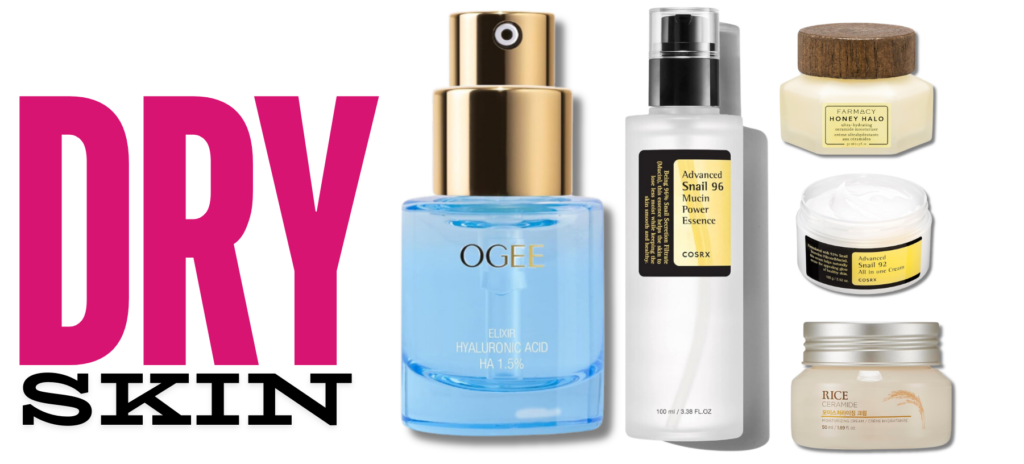
- Ogee Hyaluronic Acid Elixir (Sodium Hyaluronate best for dry skin)
- Cosrx Snail Mucin Repair Cream
- Cosrx Snail Mucin Essence (IF, only IF applying ceramides after otherwise this essence may feel “too dry” for you)
- Farmacy Honey Halo Ceramide Moisturizer
- The Face Shop Rice Ceramide Moisturizer
Aging Skin: Hyaluronic Acid + Snail Mucin + Peptides
Why?
Aging skin benefits from hydration, repair, and collagen stimulation. Hyaluronic acid hydrates and plumps the skin, reducing the appearance of fine lines.
Snail mucin repairs and regenerates, while peptides boost collagen production, improving skin elasticity and firmness. This combo targets multiple signs of aging, keeping skin youthful and vibrant.
I love these options for mature skin (that’s 35+ in case you’re doubting) 🥰 👌
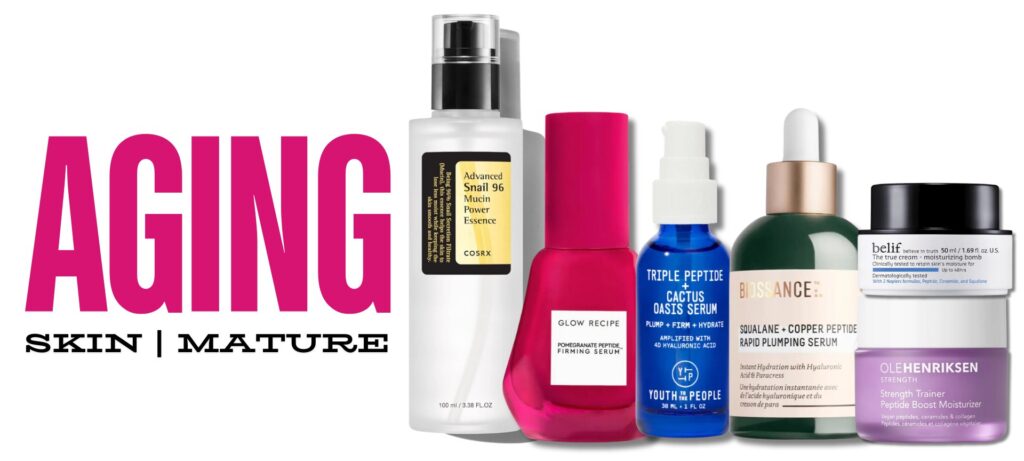
- Ogee Hyaluronic Acid Elixir
- Cosrx Snail Mucin Essence
- Biossance Squalane HA+ Copper Peptide Serum
- Belif The True Cream Moisturizing Bomb with Peptide and Ceramide
- Youth To The People Triple Peptide Serum with HA
- Glow recipe pomegranate peptide serum
Hyperpigmentation: Hyaluronic Acid + Snail Mucin + Vitamin C
Why?
Hyperpigmented skin needs brightening and repair. Hyaluronic acid hydrates and plumps the skin, enhancing its overall appearance. Snail mucin aids in skin repair and regeneration, reducing the appearance of dark spots.
Vitamin C is a powerful antioxidant that brightens the skin and evens out skin tone by inhibiting melanin production. This combination helps to lighten dark spots and improve skin radiance.
I love this for hyperpigmentation 👉 💕
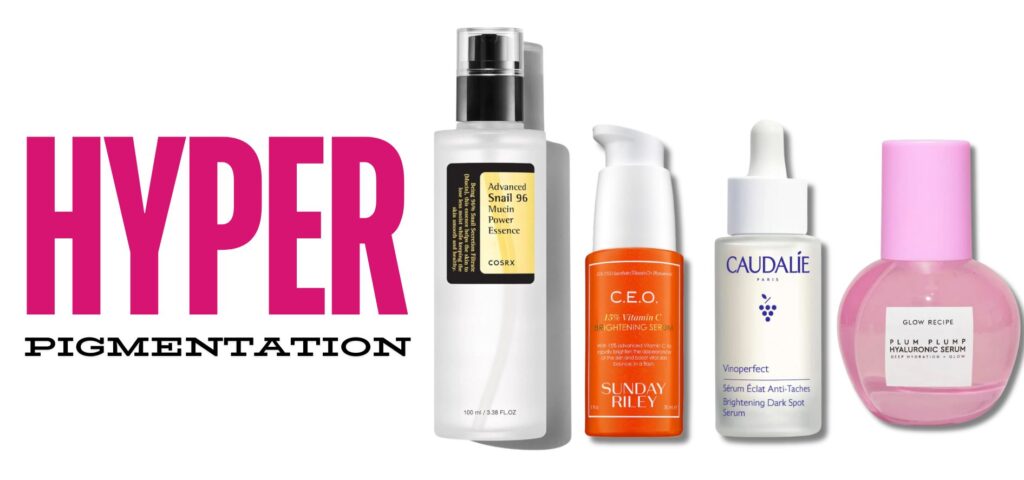
- Cosrx Snail Mucin Repair Cream
- Cosrx Snail Mucin Essence (IF, only IF applying ceramides after otherwise this essence may feel “too dry” for you)
- Innisfree: Green Tea Enzyme Vitamin C Brightening Serum
- Caudalie: Vinoperfect Brightening Dark Spot Serum (If you want to avoid Vit C)
- Sunday Riley: 15% Vitamin C Brightening Serum OR the moisturizer less concentrated but more affordable!
Oily Skin: Hyaluronic Acid + Snail Mucin + Niacinamide
Why?
Oily skin requires hydration without added grease and oil control. Hyaluronic acid provides lightweight hydration.
Snail mucin helps repair and calm the skin, while niacinamide (Vitamin B3) regulates oil production, reduces pore size, and minimizes breakouts. This combo ensures balanced hydration and a clearer complexion.
I really like options for oily skin 🥰 👌
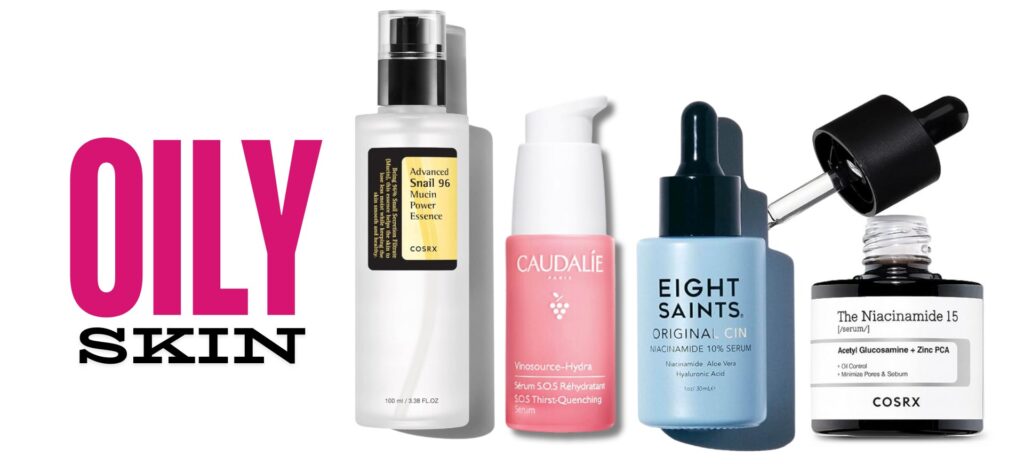
- Ogee Hyaluronic Acid Elixir
- Caudalie Vinosource S.O.S. Hyaluronic 🥰
- Cosrx Snail Mucin Essence
- Well People Pore Detox Niacinamide Refining Serum
- Eight Saints Original Cin, Niacinamide 10% Face Serum -Organic
- COSRX Niacinamide 15% Face Serum
Combination Skin: Hyaluronic Acid + Snail Mucin + Green Tea Extract
Why?
Combination skin needs hydration, repair, and balancing properties. Hyaluronic acid hydrates without weighing down oily areas.
Snail mucin repairs and soothes the skin, while green tea extract provides antioxidant protection and helps balance oil production. This trio keeps skin hydrated, calm, and balanced.
Go for this if you have combo skin 🥰 👌
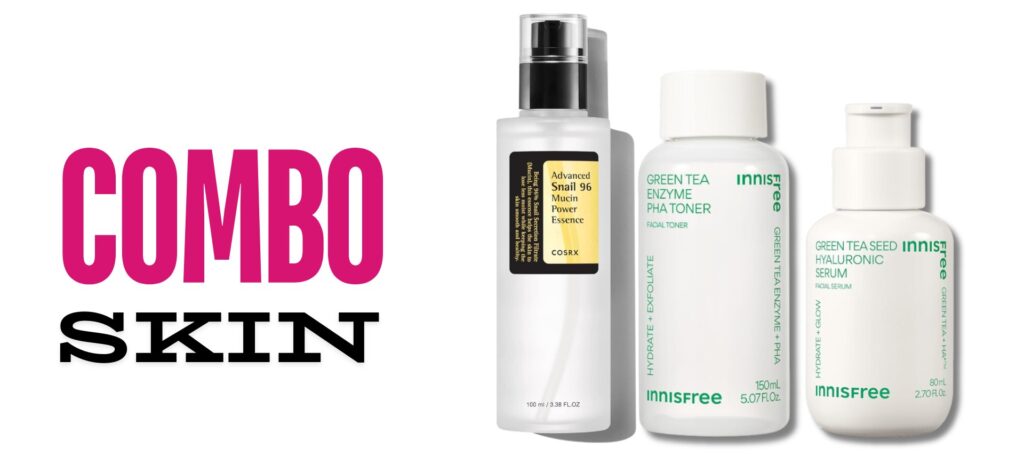
- Cosrx Snail Mucin Essence
- Innisfree Green Tea Seed Hyaluronic Serum
- Innisfree Green Tea Enzyme PHA Toner
- Cosrx Snail Mucin Repair Cream
Eczema-Prone Skin: Hyaluronic Acid + Snail Mucin + Colloidal Oatmeal
Why?
Eczema-prone skin requires intense hydration and soothing ingredients. Hyaluronic acid provides deep hydration, relieving dryness and flakiness.
Snail mucin aids in repair and regeneration, while colloidal oatmeal soothes itching and inflammation, creating a protective barrier on the skin. This combination helps to calm, hydrate, and protect sensitive, eczema-prone skin.
FAQ
Should I use snail mucin before or after hyaluronic acid serum?
You should use snail mucin before applying hyaluronic acid serum. Snail mucin is packed with active ingredients that repair and regenerate your skin. Applying it first allows these ingredients to penetrate deeply. Follow up with hyaluronic acid to lock in moisture and enhance hydration.
What should I not mix with snail mucin?
Avoid mixing snail mucin with strong exfoliants like alpha hydroxy acids (AHAs) and beta hydroxy acids (BHAs) in the same routine. These can be too harsh when combined, potentially causing irritation. It’s best to use exfoliants in a separate routine, either in the morning or on alternate days.
Can I use hyaluronic acid every day?
Yes, you can use hyaluronic acid every day, both morning and night. It’s a gentle, hydrating ingredient suitable for all skin types. Regular use helps maintain optimal skin hydration, keeping your skin plump and smooth. Just ensure you follow up with a good moisturizer to lock in the hydration.
Is snail mucin safe for sensitive skin?
Absolutely! Snail mucin is known for its soothing and healing properties, making it suitable for sensitive skin. It helps reduce redness, irritation, and inflammation while promoting skin regeneration. However, always do a patch test before adding a new product to your routine to ensure it works well with your skin.
Can I use snail mucin and hyaluronic acid together with retinol?
Yes, you can use snail mucin and hyaluronic acid with retinol. These ingredients complement retinol well. Apply retinol after cleansing and then layer snail mucin and hyaluronic acid. This combination helps to mitigate potential dryness and irritation from retinol, providing hydration and soothing benefits. Make sure to use sunscreen during the day, as retinol can increase your skin’s sensitivity to the sun.
Should I Use Snail Mucin Before Or After Moisturizer?
Yes but you need to use the the Golden Rule in Skincare: From Thinnest to Thickest. Read everything here.











